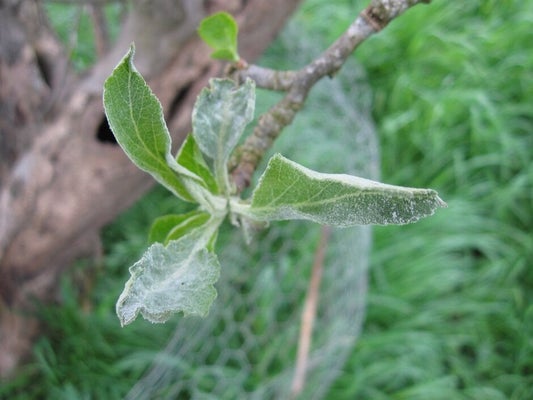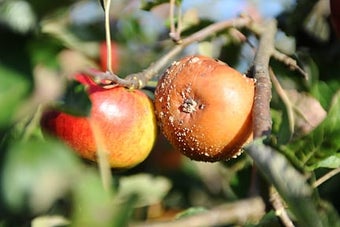
Quick facts
Common name - Apple powdery mildew
Scientific name - Podosphaera leucotricha
Plants affected - Apples, pears, quince and some other fruit trees and woody ornamentals
Main symptoms - Distortion and white fungal growth on leaves and flower buds, silvering on tips of twigs
Caused by - Fungus
Timing - The symptoms and the part of the tree affected vary according to the time of year
What is apple powdery mildew?
Apple is a disease caused by the parasitic fungus Podosphaera leucotricha. It can also affect pear, quince (Cydonia oblonga), medlar (Mespilus germanica), cherry plum (Prunus cerasifera), peach (Prunus persica), almond (Prunus dulcis) and some ornamental shrubs, such as Photinia and Spiraea. There is the potential for the disease to spread between some of these host plants, such as apple, pear and quince.
The fungus produces a range of symptoms on different parts of an apple tree, depending on the time of year.
What does apple powdery mildew look like?
Take a look at the photo gallery below for pictures of some of the symptoms caused by apple .
You may see the following:
- On emerging leafy shoots in spring (‘primary mildew’): Infected leafy shoots are usually stunted, and soon become covered with the white, powdery growth of the mildew fungus. The leaves often remain small and distorted, and may shrivel up if infection is severe
- On emerging flower clusters in spring (‘primary mildew’): Flower and flowers (if they open) are distorted and often covered in white, powdery growth. The flower petals may also appear pale green or yellow, rather than the usual white or pink
- On leaves scattered widely over the tree in summer (‘secondary mildew’): Affected leaves will often be of normal size but can be curled. White patches of mildew growth may be seen, usually on the bottom surface. The top surface might have yellow or purple blotches visible, corresponding to the fungal growth underneath. Some leaves may shrivel and fall – this depends on the apple and the severity of the infection
- On fruit: White fungal growth may be seen on the fruit of certain cultivars. On other cultivars the fungus instead causes russeting (a brown, roughened appearance to the skin) in a net-like pattern
- On twigs in winter: Twigs on which mildew is overwintering will often have a silvery appearance, particularly at the tips
Similar symptoms to these will be produced on pear and quince trees, although on quince the white, powdery growth of the fungus is often very noticeable on both leaf surfaces during the summer. On peach trees the fungal growth is seen most often on the fruit.

Does anything else look like apple powdery mildew?
The symptoms caused by are different from those of other diseases of apple trees, such as apple scab , apple canker , blossom wilt and fireblight . However, there are a few other things that could potentially be confused with powdery mildew:
Woolly aphids produce a fluffy, white, waxy material that is sometimes mistaken for the growth of a fungus. However, this is found on the woody parts of the tree rather than on the leaves.
Distortion of young growth can be caused by the feeding of some other aphid species . However, in this case there won’t be the typical white fungal growth seen with powdery mildew. You may also be able to see the aphids themselves, their cast skins, or other symptoms sometimes associated with aphid infestation, such as sticky honeydew and associated sooty mould growth.
Russeting of apple fruit can be caused by adverseweather conditions such as frost. Russeting is also a natural feature of the fruit of some cultivars (there’s sometimes a clue in the name, e.g. Egremont Russet).
Finally, some apple cultivars naturally produce a dense white covering of hairs on the leaves and young twigs. These hairs can make the growth of secondary mildew on the leaves difficult to spot, whilst on the twigs in winter they could be mistaken for the silvering caused by overwintering powdery mildew.
Management
How do you treat on apple trees?
- Removing infected shoots and flower clusters as they emerge in spring is the most important way of combatting the disease. If these primary infections are pruned out and disposed of promptly it can limit the spread of the disease over an affected tree for the rest of the growing season. The infected shoots are quite easy to identify
- Remove these primary infections with care, as the large numbers of spores present on them are easily dispersed. Place them slowly and carefully into a bag as soon as they are removed.
- Pruning in winter to remove any twigs on which the fungus is overwintering will help to prevent the emergence of primary infections in spring. The silvering symptom on the twigs is quite difficult to recognise, however, so this step could be left out if you’re not confident in identifying it
- When carrying out routine pruning of free-standing apple trees, aim to produce an open-centred crown with well-spaced branches. This will ensure good air flow through the canopy, lowering and making conditions less conducive for powdery mildew (and some other diseases such as )
- Stressed trees can be more prone to disease, so ensure that they are fed and watered as needed. Avoid using too much nitrogen fertiliser though, as this can result in a flush of rapid, ‘soft’ growth that’s more prone to infection
- These techniques can also be used to combat the disease on its other host plants
A useful tip from 911���� fruit specialist Jim Arbury is to prune out shoots with primary infection during damp, drizzly weather, when possible, as this will suppress spore release.
Which apple cultivars are most prone to mildew, and do any have resistance to it?
There are some big differences between apple cultivars in susceptibility to mildew. Amongst those commonly affected are ‘Cox’s Orange Pippin’, ‘Crispin’, ‘Elstar’, ‘Fiesta’, ‘Gala’, ‘Golden Delicious’, ‘Golden Noble’, ‘Gravenstein’, ‘Idared’, ‘Jonathan’, ‘Lane’s Prince Albert’, ‘Merton Russet’, ‘Pixie’, ‘Ribston Pippin’, ‘Saint Edmund’s Pippin’ and ‘Stirling Castle’.
Cultivars with resistance to the disease include ‘D�������DZ������’ , ‘Dummellor’s Seedling’ , ‘Edward VII’ , ‘G����Բ��徱���’ , ‘Laxton’s Fortune’ , ‘Lord Derby’ , ‘Newton Wonder’ , ‘T�DZ貹��’ and ‘Worcester Pearmain’ .
Should I use fungicides against apple mildew?
The 911���� recommends that you don’t use fungicides. Fungicides (including organic types) may reduce , impact soil health and have wider adverse environmental effects. It should be possible to get good control of the disease using the techniques described above.
What if I do nothing at all?
This is certainly a valid option, and it’s very much down to personal choice. It’s likely that a very high percentage of garden apple trees affected by mildew receive no management aimed directly at combatting it. Even a tree heavily infected with mildew will probably still produce at least some fruit, although the yield, size and quality is likely to be inferior compared to that from a healthy tree. It really depends on what you want from your tree - if your aim is to try and produce a good yield of quality fruit it’s worth taking steps to reduce the threat from mildew, or to consider a with resistance if you’re thinking of planting a new tree.
Biology
On apple trees the fungus overwinters as growth (mycelium) within colonised the previous summer. Buds that are infected this way are more prone to low temperature damage, and some may be killed during a particularly cold winter. But many will survive, and as growth resumes in spring the fungus becomes active again and colonises the emerging vegetative shoot or the flower buds, producing the symptoms of primary infection described above. By no means all of the emerging shoots or flowers on a tree will be infected, as some buds won’t have been colonised by the fungus, so a mixture of healthy and infected new growth is usually seen.
Large numbers of airborne spores are produced on these primary infections, which then spread the disease to other parts of the tree to produce the more widespread secondary infection on the leaves. Humid conditions are required for spore and infection, but extended periods of leaf wetness can prevent spores from .
The fungi are known as biotrophs; they infect the host tissues for extended periods without killing them, feeding from the living cells. The vigour of the tree will be reduced as a result - this effect is more pronounced on the most susceptible cultivars. Fruit size, quality and number will be adversely affected, and in some cultivars the fungus can also directly attack the fruit.
By the time the leaves start to fall in autumn the fungus will have colonised some of the buds, and the cycle begins again. Whilst the mildew may still be visible on some of the leaves when they fall these aren’t thought to play an important role in the overwintering of the fungus.
There is less information available on the life-cycle of Podosphaera leucotricha on its other host plants, but it’s likely to be broadly similar on most of them. It has been shown that populations of the fungus from pear and quince trees will affect apple trees and vice versa, so there appears to be little if any host specialisation.



















